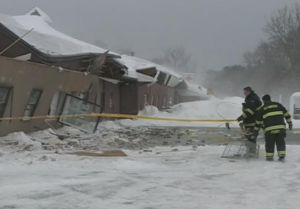Snow Loading: How to Know When the Weight of Snow Is Too Much
by Janel Giarratano, ARM with contributions from Anil Jagiasi, PE
Extreme caution should be exercised when deciding if a building is safe for occupancy or use when it comes to weight of ice and snow. There are several complicating factors that affect a roof’s ability to withstand the weight of snow including, but not limited to:
- The amount and ventilation of the insulation in the roof
- “Re-roofing” (are there more than 3 layers of shingle on the roof, which decreases the roof’s ability to hold more weight)
- Roofing materials used (shingle v. metal)
- Slope of the roof
- Depth of snow (which may vary from one part of the roof to another due to drifting and snow slide)
- Density of snow (as determined by temperature, moisture patterns and elevation)
- Amount of sunshine (which affects the melting rate, causing concentrated pools of melt and uneven weight distribution
- Snow drift (which causes unbalanced loads)
- Lower roofs which are vulnerable to snow slide from higher roofs (when upper sloped roof snow slides onto lower roof, significantly increasing the weight on the lower roof)
- New, taller buildings built adjacent to the existing lower height buildings can cause snow drifts on lower height buildings, which are not designed to handle the weight of those drifts
Structural Engineering experts investigate multiple factors that affect a roof’s or deck’s ability to withstand heavy loads of snow. Below, are just a few of those factors:
- International Building Codes (IBC) for ground snow loads
- The depth and weight of the snow (colder temperatures = lighter snow, warmer temperatures = heavier snow)
- Amount of ice under the snow
- Improperly constructed or structurally inadequate roofs
- If roof is pitched, does the roof have collar ties (collar ties are horizontal members similar to ceiling joists, but are placed at elevation higher than the ceiling joists)
- The size, spacing and material of the rafters
- The integrity of the rafters (have they ever sagged, cracked or been compromised by previous snow storms, been exposed to termites, has fire previously damaged the rafters, etc.)
- Solar panel array installation affects the snow load carrying capacity of a building’s roof.
- Ongoing roof leaks may have caused water damage to roof framing, thus compromising its ability to carry the snow load
Finally, below are some possible life-saving warning signs that a snow load may be affecting the overall structure:
- Cracked rafters or decking support
- Sagging roof framing members
- Separation of the roof rafters from the ridge beam
- Doors and windows that will no longer open with ease
- Cracking and popping sounds (GET OUT OF THE BUILDING!)
- Rule of thumb for flat roofs – any snow accumulation of over 12” is excessive. This is because most flat roofs are designed for minimum 20 psf load. Most buildings built in areas with ground snow load 40 psf or less (per code), are most likely not capable of handling the weight of 12” or more.
If your property is at risk of collapse, hire an expert to perform a thorough investigation. This can not only save lives and prevent injury, but can often prevent the total loss of a building at risk, as experts can advise on how to protect the building from impending collapse. When the public’s safety is of concern, extreme prudence is best.




